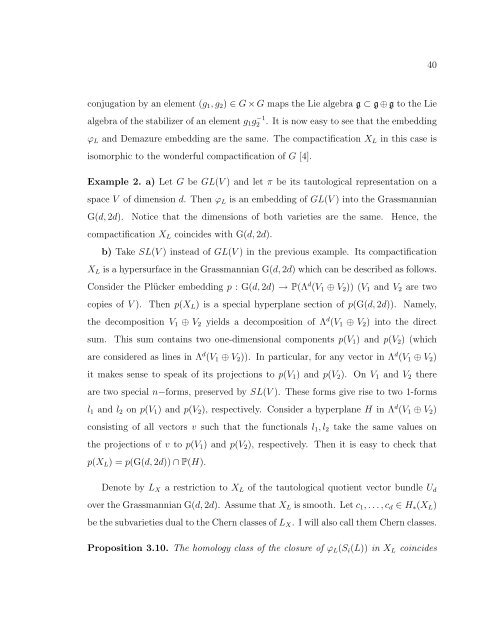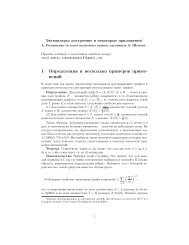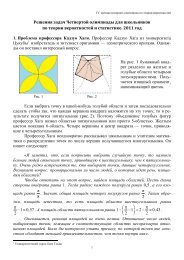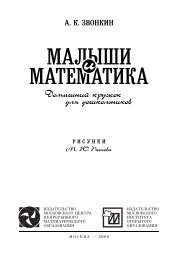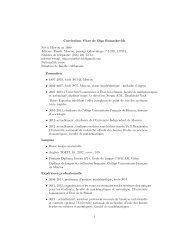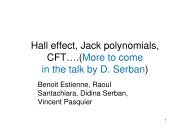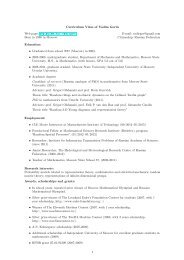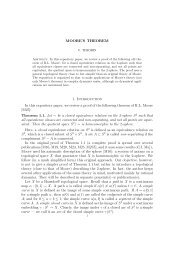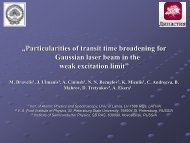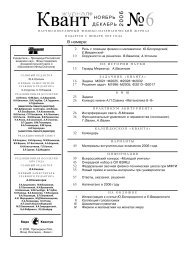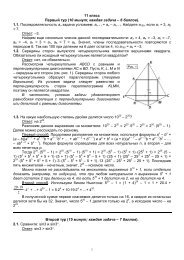a gauss-bonnet theorem, chern classes and an adjunction formula
a gauss-bonnet theorem, chern classes and an adjunction formula
a gauss-bonnet theorem, chern classes and an adjunction formula
Create successful ePaper yourself
Turn your PDF publications into a flip-book with our unique Google optimized e-Paper software.
40<br />
conjugation by <strong>an</strong> element (g 1 , g 2 ) ∈ G × G maps the Lie algebra g ⊂ g ⊕ g to the Lie<br />
algebra of the stabilizer of <strong>an</strong> element g 1 g −1<br />
2 . It is now easy to see that the embedding<br />
ϕ L <strong><strong>an</strong>d</strong> Demazure embedding are the same. The compactification X L in this case is<br />
isomorphic to the wonderful compactification of G [4].<br />
Example 2. a) Let G be GL(V ) <strong><strong>an</strong>d</strong> let π be its tautological representation on a<br />
space V of dimension d. Then ϕ L is <strong>an</strong> embedding of GL(V ) into the Grassm<strong>an</strong>ni<strong>an</strong><br />
G(d, 2d). Notice that the dimensions of both varieties are the same. Hence, the<br />
compactification X L coincides with G(d, 2d).<br />
b) Take SL(V ) instead of GL(V ) in the previous example. Its compactification<br />
X L is a hypersurface in the Grassm<strong>an</strong>ni<strong>an</strong> G(d, 2d) which c<strong>an</strong> be described as follows.<br />
Consider the Plücker embedding p : G(d, 2d) → P(Λ d (V 1 ⊕ V 2 )) (V 1 <strong><strong>an</strong>d</strong> V 2 are two<br />
copies of V ). Then p(X L ) is a special hyperpl<strong>an</strong>e section of p(G(d, 2d)). Namely,<br />
the decomposition V 1 ⊕ V 2<br />
yields a decomposition of Λ d (V 1 ⊕ V 2 ) into the direct<br />
sum. This sum contains two one-dimensional components p(V 1 ) <strong><strong>an</strong>d</strong> p(V 2 ) (which<br />
are considered as lines in Λ d (V 1 ⊕ V 2 )). In particular, for <strong>an</strong>y vector in Λ d (V 1 ⊕ V 2 )<br />
it makes sense to speak of its projections to p(V 1 ) <strong><strong>an</strong>d</strong> p(V 2 ). On V 1 <strong><strong>an</strong>d</strong> V 2 there<br />
are two special n−forms, preserved by SL(V ). These forms give rise to two 1-forms<br />
l 1 <strong><strong>an</strong>d</strong> l 2 on p(V 1 ) <strong><strong>an</strong>d</strong> p(V 2 ), respectively. Consider a hyperpl<strong>an</strong>e H in Λ d (V 1 ⊕ V 2 )<br />
consisting of all vectors v such that the functionals l 1 , l 2 take the same values on<br />
the projections of v to p(V 1 ) <strong><strong>an</strong>d</strong> p(V 2 ), respectively. Then it is easy to check that<br />
p(X L ) = p(G(d, 2d)) ∩ P(H).<br />
Denote by L X a restriction to X L of the tautological quotient vector bundle U d<br />
over the Grassm<strong>an</strong>ni<strong>an</strong> G(d, 2d). Assume that X L is smooth. Let c 1 , . . . , c d ∈ H ∗ (X L )<br />
be the subvarieties dual to the Chern <strong>classes</strong> of L X . I will also call them Chern <strong>classes</strong>.<br />
Proposition 3.10. The homology class of the closure of ϕ L (S i (L)) in X L coincides


